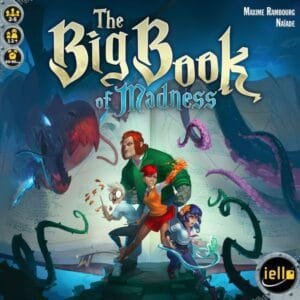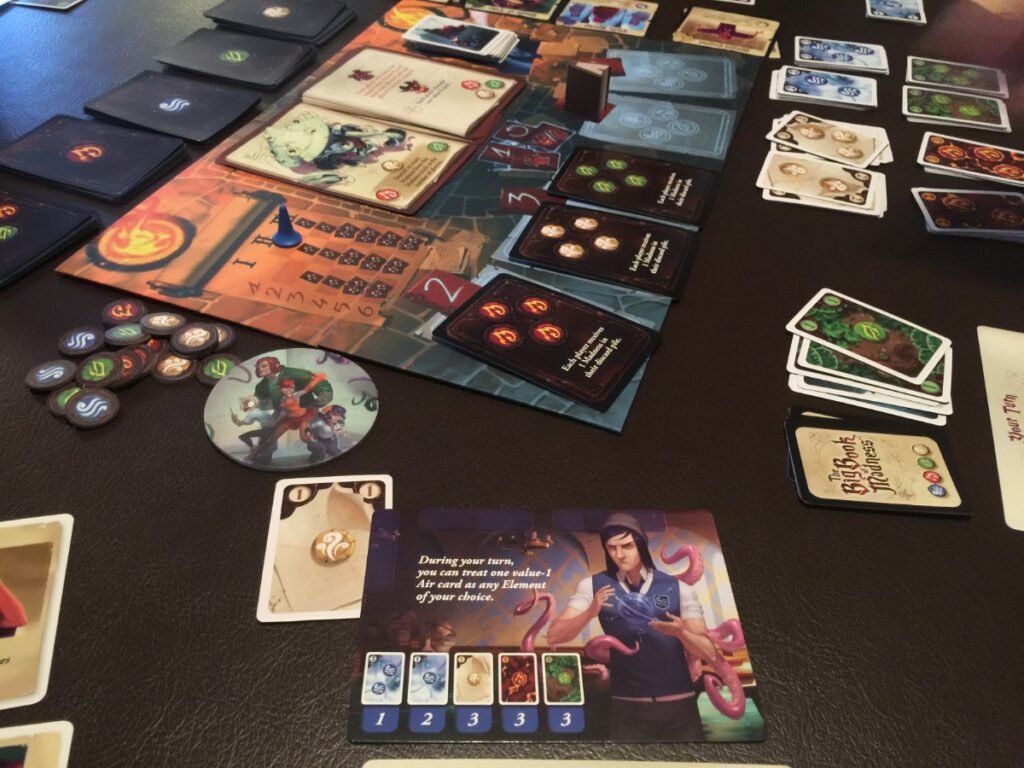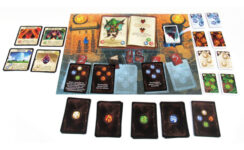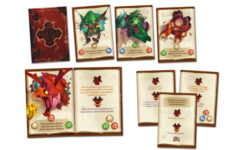The Big Book of Madness Review
Year: 2015 | Players: 2-5 | Minutes: 60+ | Ages: 12+
This The Big Book of Madness review was made after playing the game eight times.
What is The Big Book of Madness?
The Big Book of Madness is a cooperative deck building game designed by Maxime Rambourg and published by IELLO in which players are students of magic who must work as a team to defeat monsters that are coming out of a grimoire. As the monsters are released from the book’s pages, you must use the school’s library to figure out how to deal with their curses.
Rules Overview
At the beginning of a game of The Big Book of Madness, players get to choose their students. The students start with the same four basic spells, but they also have their own unique starting decks and special abilities.
The Madness deck is your enemy in this game. Some of the monsters (and their curses) will force you to take madness cards, which clog up your deck and slow you down. These cards are tough to get rid of and can’t be discarded at the end of your turn. If you ever end up with a hand full of madness cards, you will be out of the game (because you’ve gone mad!).
You begin each turn with six cards in your hand and you must figure out the best way to use them. During the action phase, you will use your element cards to deal with curses; upgrade your deck with higher-valued elements; cure madness; or learn better spells.
Another option that you have during your turn is to add one of your cards to the support pool. This is a great way to work cooperatively to destroy curses or to get madness cards out of other players’ hands.
The game has six rounds, and in each round players face a different monster with a different mix of curses. You don’t have to defeat all of the monsters, but you do have to beat the last monster in the book. It is pretty much impossible to beat that sixth monster without destroying many of the other monsters’ curses, so you can’t just skip them.
If the players are able to destroy all of a monster’s curses during a round, they will all get a bonus. If they leave even one curse, then they will all suffer the failure penalty.
So, to sum up, there are three ways to lose:
- Running out of madness cards.
- All players going mad.
- Failing to defeat the final monster.
The only way to beat the game is to destroy all of the final monster’s curses.
That is a very brief overview of how to play The Big Book of Madness. If you’d like to see exactly how this game plays, check out The Big Book of Madness rulebook (PDF).
Pros and Cons
Pros
- Possibly the best thing about The Big Book of Madness is that you have to constantly adjust your strategies as the pages of the book turn. You don’t have much of a chance without good cooperation (by using the support pool), which is something I always like to see in co-op games.
- The characters’ unique abilities and starting decks do the job of making them feel like they all bring something different to the table. For example, if you have a character that starts out with more Fire element cards, you know that you’ll be able to help out the team should a curse card pop up that requires fire.
- This game has amazing artwork. Artist Xavier Gueniffey Durin (Seasons, Tokaido) did a fantastic job making the board, cards and monsters come to life through his drawings. Even if you don’t end up being a huge fan of the game, you will probably end up agreeing that it’s some of the best board game art out there right now.
- The Big Book of Madness also has a good amount of replayability. You will very rarely face the same sets of monsters, and the upgraded spells that you can buy will usually be different, too.
- This is not a heavily thematic game, but the unique monsters, the element cards and the spell cards do enough to keep you engaged throughout the game.
Cons
- Setup is a bit of a pain since you have to put together multiple decks of cards and you have to lay all of those cards out around the table. You’re looking at a good 5-10 minutes of setup time, which isn’t too bad, but is more than you’d expect from a game of this weight.
- It also takes up a fair bit of table space since you have all of those decks of cards and everyone’s own personal boards and cards.
- It would have been nice if each of the characters had a short bio to add a bit more to the theme. They feel pretty generic without any background information.
Final Thoughts
The Big Book of Madness is a very good co-op deck builder. It has mechanics found in other deck building games, but it also has its on cool twists with the support pools and the fact that you can “pay” for abilities that start out in play. The recommended playing age is 12+, but younger kids could play it if someone goes over each part of their turns with them. It could definitely work as a slightly heavier family game.
I’m going to keep The Big Book of Madness in my gaming rotation because it’s challenging, has fantastic artwork and because it has plenty of replayability. It’s not on my group’s top cooperative board games list, but everyone I’ve introduced it to has enjoyed it; in fact, it’s worked quite well as a gateway game for multiple people.
The Big Book of Madness Links
BGG | Amazon | CoolStuffInc | eBay
Thanks for taking the time to read our The Big Book of Madness review!
Be sure to also take a look at our Best Cooperative Board Games list and other rankings.
To stay updated on all things co-op board games and card games, follow us on Facebook and X.




